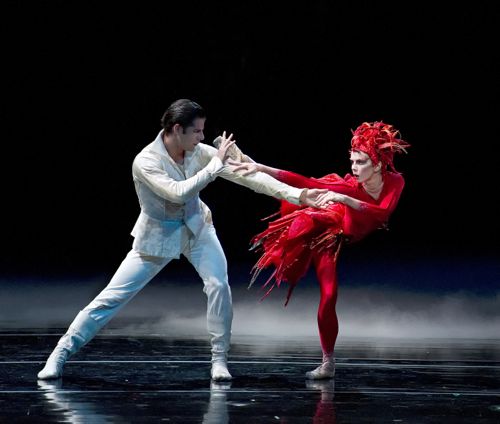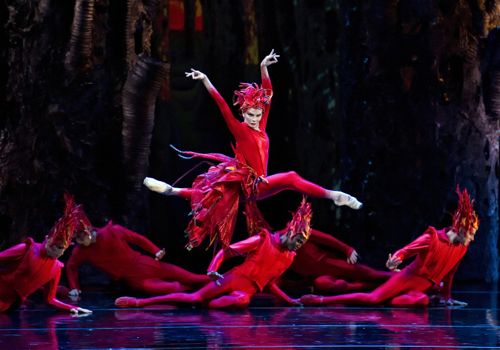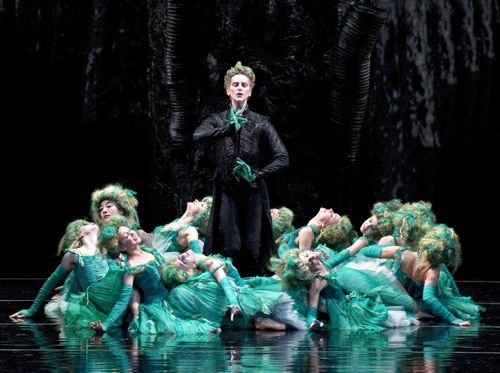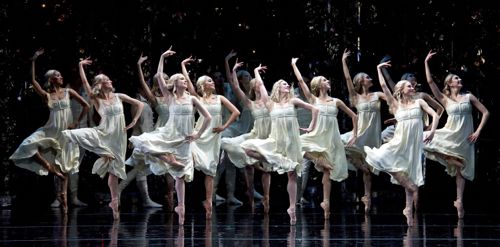American Ballet Theatre: Alexei Ratmansky’s new Firebird / Metropolitan Opera House, Lincoln Center, NYC / season runs through July 7, 2012
I can’t imagine what Alexei Ratmansky was thinking of in creating his New Look Firebird. To begin with—and this is the first thing you notice–it‘s dressed for Las Vegas by Galina Solovyeva, with complementary décor (including a sci-fi forest with hints of porn) by Simon Pastukh. It wrests the fairy-tale narrative that Michel Fokine created for his 1910 L’Oiseau de Feu (in which good, abetted by generosity, duly conquers evil and is rewarded with love) into a tale that is sardonic at best, sleazy at worst.
 Marcelo Gomes as Ivan and Natalia Osipova as the Firebird in Alexei Ratmansky’s re-imagination of Firebird for American Ballet Theatre
Marcelo Gomes as Ivan and Natalia Osipova as the Firebird in Alexei Ratmansky’s re-imagination of Firebird for American Ballet Theatre
Photo: Gene Schiavone
Am I prejudiced by past experience? I first saw the Fokine version back in the day with Margot Fonteyn and can still remember her entrance and her boldly plucking a golden apple from a painted tree. The one civilized thing Ratmansky accomplished with his version was to use the full Stravinsky score instead of the customary suite. Of course that only lengthened the discomfort of the naysayers.
Judging from all I’ve seen of his earlier work, I’m convinced that Ratmansky is a humanist at heart. His ballets exude a wide and deep sympathy for the flawed human race; call it love, if you will, or, rather, love leavened with humor. As an artist—and he’s a major one, the very best we have in ballet—he has every right to see the world as loathsome, but he’ll have to make his case better than he does here.
 Osipova with part of the Firebird ensemble
Osipova with part of the Firebird ensemble
Photo: Gene Schiavone
Just so you know, the Firebird in this version comes as a multiple. There’s a whole flock of this rara avis, available in both genders. In real-life birdland—with the cardinal, for example—there’s a color distinction or other marking of the genders. Not here. Male and female alike, they’re poured into screaming-red unitards and sport headpieces ornamented with sheaves of feathers that reach into the air like flames, threatening to consume its oxygen.
Of course there’s a main Firebird, as well (her get-up includes a feathery bustle at the rump). I saw her danced by Natalia Osipova. Ratmansky has chosen to ignore this ballerina’s remarkable buoyancy and, with his enormous insight into who and what an individual dancer is, concentrated on another aspect of her dancing persona—a toughness that she seems eager to discard. It’s shown off very well, though, in her battle with Ivan—a tsarevich type played by Marcelo Gomes, who’s the curiosity-driven hero of the ballet—when he tries to capture her. He releases her finally and she rewards him with a red feather that he can use to summon her when he’s in need. Just as everything in the ballet is “too big,” so is the feather.
 David Hallberg as the monster Kaschei with the Maidens under his spell
David Hallberg as the monster Kaschei with the Maidens under his spell
Photo: Gene Schiavone
The Maidens (lovely, gentle, and presumably virginal according to Fokine) whom the monster Kaschei holds in his thrall are, chez Ratmansky, plain and simple sex slaves. The choreographer makes this clear by, for instance, having them assemble, packed body to body in a horizontal line, so that he can slide his lips onto each mouth with a single kiss. There’s a main Maiden, intended in the end as Ivan’s reward, who not only shares a grotesqueness (and a turquoise wardrobe) with her sisters but is, as played by Simone Messmer, also wittier.
As Kaschei, David Hallberg (the incomparable classicist who, half an hour earlier, had been dancing the title role in Balanchine’s Apollo) was clearly having the time of his life being a campy Essence of Evil. But Ivan, after wielding the Emergency Feather, discovers the egg that harbors K’s soul and smashes it, leading to an unearned, unconvincing, and dumbly inept Happy Ending.
 The Maidens, free at last
The Maidens, free at last
Photo: Gene Schiavone
I should add that there’s almost no distinctive dancing in the piece but this, given the circumstances Ratmansky set up or succumbed to, was inevitable.
© 2012 Tobi Tobias




Elvis was an inspiration …
Rarely do I disagree with you,Tobi, but I think you don’t do this vision justice. I have never seen an original or even close to an original “Firebird”; the City Ballet version somehow doesn’t quite live up to what I imagine the Fokine version was about. But this version is a Russian fairy tale from a choreographer who has emerged from Putin’s Russia to create brilliant ballets that have to do with Russian life — whether communist, fairy tale, or post-communist. At each and every point he presents aspects of life in Russia that reveal new aspects of this society. So “Firebird” reveals what bothers Ratmansky about Russian life today: an authoritarian world that exploits and regulates. This is not Russia 1910 where Fokine imagined a new world; this is 2012 where Putin’s power expands and smothers ideas and creativity. All of that is in this garish but visually exciting vision Ratmansky presented. The deindustrialized scenery does turn into the Cathedral that reminded me of Eisenstein’s “Ivan the Terrible.” Those Green maidens were witty and wonderful in those green prom dresses, and even the so-called happy ending suggested a totalitarian sameness that was more frightening than a happy ending. Ratmansky created a ballet for HIS era, not Fokine’s, although he certainly pays homage to the orientalism of the Ballets Russes and its outrageousness. It is important to remember that when these ballets were first performed the audience hated them and hissed roundly. Perhaps this is what Ratmansky had in mind when he gave this production a Las Vegas-Russian style gloss? It certainly isn’t out of keeping with the new Russia and its over the top politics and style.
The scenery, a forest of what seems to be a forest of semi-abandoned industrial buildings, which glow brightly from pollution and chemicals, seems to have been inspired by Tarkovsky’s abandoned waste sites in his films. Eventually the forest turns into what looks like a Romanesque Cathedral once the sorcerer Kaschei enters. Yet this cathedral is clearly not the wonderful god-filled world of the Middle Ages, but closer to the final crazed moments of Eisenstein’s “Ivan the Terrible,” when the film bursts into blazing technicolor.
What an interesting review! I must say the photos make the production look lurid indeed, painfully so. And I don’t know why “Firebird” lends itself so well to Las Vegas interpretations–Dance Theatre of Harlem’s years ago, which I actually quite liked, had a Caesar’s Palace ending with the Firebird hovering over the cast, taking their bows, perched on a trapeze. Has Ratmansky seen Béjart’s “Firebird,” do you suppose, with an all-male cast as I recall of red unitard clad Firebirds? The recent re-imagining that I’ve seen, and liked quite a lot, is Yuri Possokhov’s, the sets and costumes maintain the fairy tale tone, the scene with the golden apples is totally charming, and when Oregon Ballet Theatre premiered it, at artistic director Christopher Stowell’s request, children from the school were cast as monsters. Balanchine’s was the first ballet I saw, at the old City Center, with Tallchief as the Firebird, and for the 11 year old girl I was at the time, her performance was empowering: she made me think I could do anything I wanted to, because she could.
I saw this one (with my kids ages 9 and 4). Seeing it through their eyes, we tried to follow the story, but having just seen “Apollo” and “13 Diversions,” we already knew that it was difficult to follow the action (in ballet). I enjoyed some of the dancing but it was ever so fleeting. I was surprised that the leads (Firebird and Maiden) were dressed exactly like the corps de ballet, but in thinking further, it reminded me of the communist ideal, where everyone is the same, nothing special (or all are special!). Some image reminded me of movies and things: the ensemble of firebirds in their fire-engine red, spiny costumes, reminded me of a pot full of crayfish, squirming around. And at the end with everyone in white, after the “spell” had been broken, everyone in white costumes and blonde wigs, this reminded me of the cult in 1960 version of the film “The Time Machine,” where the Morlocks are also all in white and walk around like virginal zombies! I did like that the men came out from inside of “the trees”, I wonder if they had been locked in for the duration and if so what were they doing with their downtime? To this I had thought of an animated film I’d seen ” Kirikou and the Sorceress” an African tale, about a sorceress who mesmerizes all the men of the village and enslaves them to do her bidding (kind of like “Giselle” or “Swan Lake”) and then Kirikou, a boy, who, with kindness and gumption, manages to heal the pained (and therefore, mean) sorceress, she realizes her own evil ways and releases the spell that holds the men, and they return to the women in the village, with open arms, and Kirikou and the Sorceress (now a beautiful woman) fall in love and marry….so the ballet put me on a visual journey in my memories, for me not altogether bad!
He should have used the suite, as he did not have enough ideas to fill the music. I agree with you re the chief bird role. The maidens were great. They are a witty, surreal updating of an outdated fable. Hallberg and Messmer were outstanding.
I felt that the whole thing read like a strange dream. One of the things I like about Ratmansky is that he is still able to surprise us. He breaks certain “rules” of what we expect, and we’re not sure if we like it. On second viewing, maybe our minds begin to change, and by the third, who knows? But then again, such a radical take is bound to be divisive. And that’s good too!
Wow, how colourful the colors are! I liked Ratmansky for what he did here in Copenhagen, but …
According to and inspired by T.T:
Avoid the A. Ratmansky show.
Are you invited, please say “no!”
Oh, T., you sent your words to me.
Las Vegas, I don’t need to see.
Set fire to Ratmansky’s bird,
Enjoy a sound you never heard.
Just trust what T. Tobias writes
and sleep through Firebird-less nights.
Note: Jan Dornonville de la Cour, a direct descendant of the celebrated 19th-century Danish choreographer August Bournonville, is a physician, a painter, and a composer of doggerel verse in his mother tongue and in English. –Ed.
Ann Ilan Alter’s comments are the only ones I’ve read that might inspire me to look at this “Firebird” in a new light, as a commentary on today’s (apparently very very depressing) Russia.
Mostly I was bored out of my mind, and knowing what was coming in advance did not help on a second viewing.
This “Firebird” is a loser. The new choreography is repetitive and boring, the scenery overpowering; the music is, as always, splendid. Osipova (in for Misty Copeland, who is injured) was her marvelous self but it’s a vapid approach. I’m surprised because I usually like what Ratmansky does.